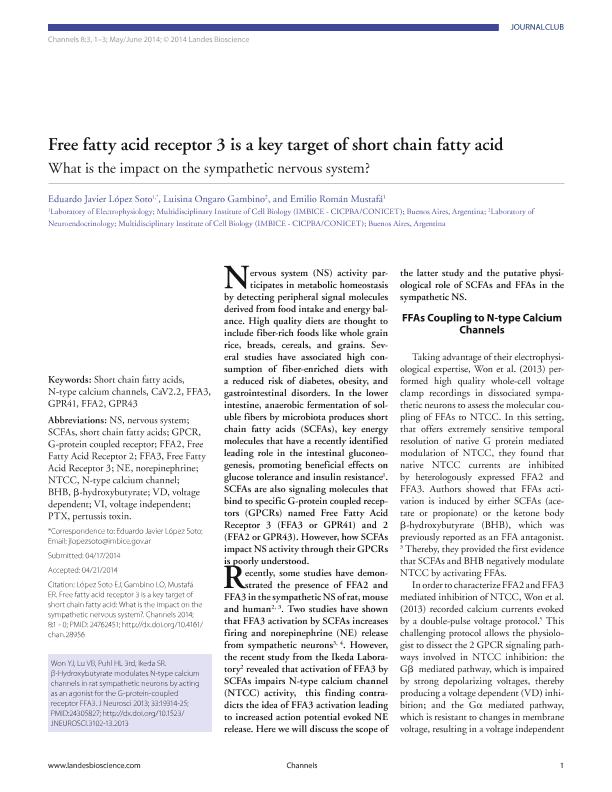Artículo
Free fatty acid receptor 3 is a key target of short chain fatty acid. What is the impact on the sympathetic nervous system?
Fecha de publicación:
04/2014
Editorial:
Landes Bioscience
Revista:
Channels
ISSN:
1933-6950
Idioma:
Inglés
Tipo de recurso:
Artículo publicado
Clasificación temática:
Resumen
Nervous system (NS) activity participates in metabolic homeostasis by detecting peripheral signal molecules derived from food intake and energy balance. High quality diets are thought to include fiber-rich foods like whole grain rice, breads, cereals, and grains. Several studies have associated high consumption of fiber-enriched diets with a reduced risk of diabetes, obesity, and gastrointestinal disorders. In the lower intestine, anaerobic fermentation of soluble fibers by microbiota produces short chain fatty acids (SCFAs), key energy molecules that have a recent identified leading role in the intestinal gluconeogenesis, promoting beneficial effects on glucose tolerance and insulin resistance1. SCFAs are also signaling molecules that bind to specific G-protein coupled receptors (GPCRs) named Free Fatty Acid Receptor 3 (FFA3, GPR41) and 2 (FFA2, GPR43). However, how SCFAs impact NS activity through their GPCRs is poorly understood. Recently, studies have demonstrated the presence of FFA2 and FFA3 in the sympathetic NS of rat, mouse and human2, 3. Two studies have showed that FFA3 activation by SCFAs increases firing and norepinephrine (NE) release from sympathetic neurons3, 4. However, the recent study from the Ikeda Laboratory2 revealed that activation of FFA3 by SCFAs impairs N-type calcium channel (NTCC) activity, which contradicts the idea of FFA3 activation leading to increased action potential evoked NE release. Here we will discuss the scope of the latter study and the putative physiological role of SCFAs and FFAs in the sympathetic NS.
Palabras clave:
Short Chain Fatty Acids
,
N-Type Calcium Channels
,
Cav2.2
,
Ffa3
,
Gpr41
,
Ffa2
,
Gpr43
Archivos asociados
Licencia
Identificadores
Colecciones
Articulos(IMBICE)
Articulos de INST.MULTIDISCIPL.DE BIOLOGIA CELULAR (I)
Articulos de INST.MULTIDISCIPL.DE BIOLOGIA CELULAR (I)
Citación
López Soto, Eduardo Javier; Ongaro Gambino, Luisina; Mustafá, Emilio Román; Free fatty acid receptor 3 is a key target of short chain fatty acid. What is the impact on the sympathetic nervous system?; Landes Bioscience; Channels; 8; 4-2014; 1-3
Compartir
Altmétricas




